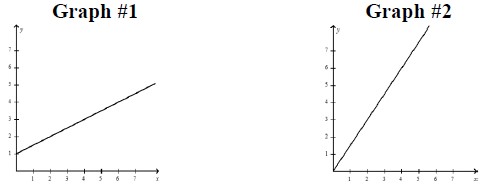General Information
Benchmark Instructional Guide
Connecting Benchmarks/Horizontal Alignment
Terms from the K-12 Glossary
- Constant of Proportionality
- Proportional Relationship
Vertical Alignment
Previous Benchmarks
Next Benchmarks
Purpose and Instructional Strategies
In grade 7, students determined if two quantities are in a proportional relationship from a table and determined the constant of proportionality. In grade 8, students determine whether a given linear relationship is also a proportional relationship. In Algebra 1, students will use two-variable linear equations to represent mathematical or real-world contexts.- Instruction includes using a variety of variables to represent the slope, which is the same as the constant of proportionality when the linear relationship is also a proportional relationship. Students used or in grade 7 to represent the constant of proportionality and now in grade 8 may use to represent slope. Students should understand that the slope or constant rate of change can be represented by any variable.
- Instruction includes students graphing relationships and writing equations to determine if two linearly related quantities are also in a proportional. Students need to be provided examples to show evidence that not all linear relationships are proportional.
- Students should connect unit rates, the constant of proportionality and slope in order to represent similar ideas in different contexts.
Common Misconceptions or Errors
- Students may incorrectly state a relationship is not proportional if the origin is not visible in the graph or given in the table.
- Students may incorrectly think all linear relationships are proportional. Some students find a constant rate of change and confuse this with a constant ratio. Help students understand that a constant ratio is only possible if the relationship passes through the origin.
Strategies to Support Tiered Instruction
- Instruction includes providing opportunities to explore relationships represented on graphs and in tables that do not include the origin. Students should determine the rate of change in these situations and use ratio reasoning to determine if the relationships pass through the origin or not.
- Instruction includes the use of geometric software to visually compare proportional and non-proportional graphs to model that all linear graphs are not proportional relationships.
- Teacher co-creates a graphic organizer to represent the similarities and differences of the terms: unit rate, constant of proportionality, and slope. Specifically include the different contexts applicable to each.
Instructional Tasks
Instructional Task 1 (MTR.4.1, MTR.6.1, MTR.7.1)A student is making trail mix for each serving size in the table given.

- Part A. Is this relationship linear? If so, state the constant rate of change.
- Part B. Determine if this relationship is also proportional.
- Part C. What do you notice about the number of cups of nuts and fruit that would be in a serving size of zero? Discuss with a partner.
Instructional Task 2 (MTR.4.1)
Part B. Which graph represents a proportional relationship? Justify your answer.

Instructional Items
Instructional Item 1Alexia earns $14.75 an hour as a hostess at a local restaurant. She earns an additional $30 in tips each night from take-out orders. Determine if this linear relationship is proportional.
Instructional Item 2
The circumference of a circle is proportional to its diameter. This relationship can be expressed by the equation = π. Determine if this linear relationship is proportional.
*The strategies, tasks and items included in the B1G-M are examples and should not be considered comprehensive.
